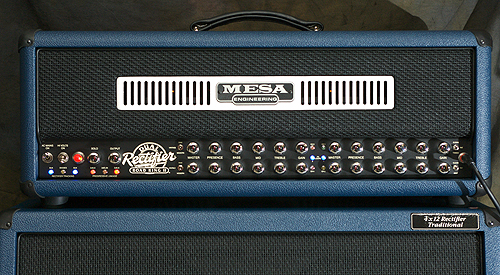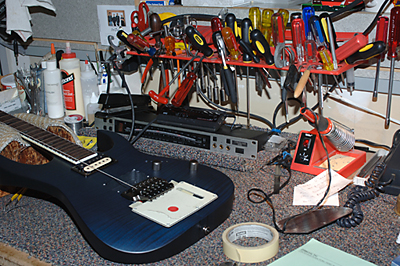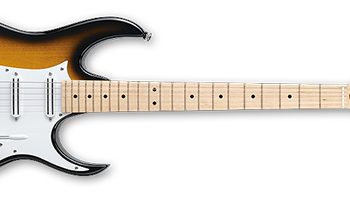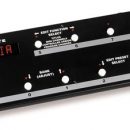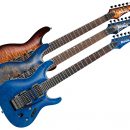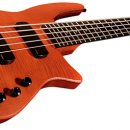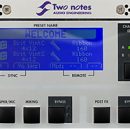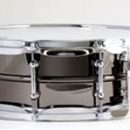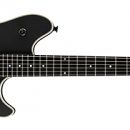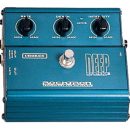Perhaps one of the most misunderstood components of the electric guitar is its pickups. Ironically, pickups are one of the most untapped resources for custom tailoring your signature sound, a far less-costly process than replacing amps, speakers, and effect systems. Because MusicPlayers.com cares about your tone, we want to clarify a few things about pickups and offer some sage advice.
This tutorial will give you an essential primer for understanding pickups, and our second pickup tutorial (Pickups 201: Pickup Replacement) walks you through the entire process of replacing your pickups just in case what we talk about here inspires you to take things to the next step.
To begin with, modern electric guitar pickups can be active or passive designs. Active designs incorporate an internal power supply (such as a nine Volt battery) and internal preamp circuitry to provide much lower impedance and higher signal levels than passive designs. Since passive guitar pickup designs still make up the majority of pickups being used today and all vintage models are of passive design, we will focus our discussion on passive pickups and leave the topic of active designs for a future article.
Passive electric guitar pickups are created by winding a coil of conductive wire around a permanent magnet, working on the principals outlined in Faraday’s Law. Without getting into the mathematical side of things, and specifically for our purposes, it can be stated that:
Any change in the magnetic environment of a coil of wire will induce a voltage in the coil.
This induced voltage (emf) can be created in a number of ways, so long as the magnetic
environment is affected. For instance, the change could be produced by moving the coil
into or out of the magnetic field, changing the strength of the magnetic field (strength of
the magnet in our case), moving the magnet toward or away from the coil,
rotating the coil relative to the magnet, etc.
The way that pickups generate a signal is by changing the magnetic environment in direct relation to the vibration of guitar strings.
Obviously, your pickups don’t move, therefore neither the magnet nor the coil are moving, but your guitar strings do move. The movement of your guitar strings causes a change in the magnetic field. From our scientific explanation, we know that:
Any time a ferrous material is placed within a magnetic field,
it will warp the magnetic flux lines.
Therefore, when our steel guitar strings vibrate within the field of the fixed pickup magnet, they cause the magnetic field to vibrate as well. The motion of the magnetic flux lines relative to the conductor (the coil of copper wire within our pickup) is what generates an electrical signal.
Before, we stated that moving the coil into or out of the magnetic field induces a voltage in the coil. If we look at things from the perspective of the magnetic field or magnetic flux lines (which are moving relative to the guitar strings), we see that the pickup (and therefore its coil) moves relative to these. Whenever there is relative motion between magnetic flux lines and an electrical conductor (the copper coil wire in our pickup) an electrical signal will be generated in the conductor.
The strength of the induced voltage (and therefore the generated signal) depends on how strong those flux lines are, how much (how many coils) of the conductor cut the magnetic flux lines, how fast the relative motion is, etc.
In layman’s terms, this means that the composition, gauge, and number of turns of wire on the coil, as well as the composition and strength of the magnet, will all have an impact on the signal generated. The gauge and composition of the guitar strings being used will also have an impact.
There are numerous aftermarket replacement pickups available today, which affords discriminating guitarists the opportunity to further customize their sound. Whether you want to replicate the bell-like tones of a vintage ’54 Stratocaster or conjure forth insane levels of aggressive crunch, there are many pickups for you to consider if your guitar’s stock selection leaves you wanting. That said, it is important to understand a few basic terms before embarking on your quest for ultimate pickup tone, so we’ll spend some time preparing you for the journey.
Single Coil Versus Humbucking (Dual Coil) Pick-ups
The defining aspect of single coil pickups, or simply single coils as they are often called, is that they contain only one coil of wire as its conductor. The pickup may contain a single magnet, a single magnet with adjustable pole pieces, or individual magnets for each guitar string, but there will be only one coil of wire wrapped around the magnet.
Because of its design, single coil pickups are susceptible to many forms of electromagnetic radiation such as sixty-cycle hum, noise from fluorescent lighting, etc. Tonally, single coil pickups often tend to be lower in output, brighter, and more open sounding than humbuckers. The single coil pickup is most commonly associated with traditional Fender Stratocaster designs.

Fender Eric Johnson Stratocaster with three special design Custom Shop Eric Johnson pickups.
Humbucking pickups, or humbuckers as they are often called, are basically two single coil pickups wired together in phase (and most often in series) in such a way that their magnets are of a reverse polarity to one another.
The polarity of the signal created by the guitar strings is dependent upon both the direction of the coil winding and the polarity of the magnet. The unwanted signal created by EMF, RFI, and other noise is dependent only on the direction of the coil windings and is independent of the polarity of the magnets. This allows the desired signal from each coil to be combined in such a way that its signal strength is reinforced (each coil yielding a signal of the same polarity) while the noise from each coil can be reduced (each coil yielding a signal of opposite polarity).
In layman terms, this means that the guitar signal from each half of the pickup (one single coil) can be added together to make a more powerful signal, while the hum is canceled (or bucked). Tonally, humbuckers often tend to be higher in output, darker, and thicker than single coil pickups. Common examples of humbuckers are PAF (Patent Applied For) type pickups found in vintage Gibson ES-335’s and many Les Pauls.
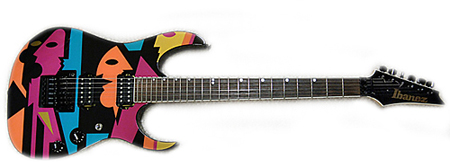
Ibanez JPM-100 P2 with DiMarzio Steve's Special and Air Norton humbucking pickups.
Stacked Single Coils
Stacked single coils are actually dual-coil humbucking designs where the coils do not physically exist side by side, but rather one on top of the other. This pickup choice is often used to enable a humbucker to fit in the space of a single coil pickup either to preserve a certain aesthetic appearance (keep that traditional Strat look), or so that no additional routing or modifying of a guitar is needed when replacing the narrower single coil pickup with a humbucker.
Popular stacked single coils are DiMarzio’s Virtual Vintage Strat replacement pickups and Seymour Duncan’s JB Jr. You can install these into your single-coil equipped guitar without any physical modifications to the guitar (though in some instances the cavity inside the guitar may not be deep enough to accommodate the taller pickup design without some additional wood routing).
Series Versus Parallel Wiring
In guitar wiring, series and parallel methods are talked about most often when discussing humbucking or dual-coil pickups. When two coils are wired in series, they are wired in such a way that the end of one coil is connected to the beginning of the other so that the signal travels in one path along the full length of both coils.
When two coils are wired in parallel, the signal is split in two (not always equally, dependent on coil resistance) before entering the coils. Each half of the signal travels along both coil paths at the same time (in parallel) and is combined at the end of each coil.
Imagine that six people in your band represent your instrument signal, and the individual coils of a humbucker are represented by two roadways. The start of the signal chain is your rehearsal space and the end of the chain is the venue where you’ll be gigging tonight. The resistance of each coil (roadway) will determine how many people can fit into each car.
In series wiring, everyone in your band jumps into one car, drives the entire length of the first roadway, then drives the entire length of the second roadway and arrives at the gig.
In parallel wiring, the band splits up into two cars and each car takes a different roadway to the gig. Despite any differences in a number of passengers, vehicle, or length of individual roadways, both cars arrive at the gig at the same time, where the band then regroups together.
Both methods of wiring can be hum-canceling and both can be in phase or out of phase.
Series wiring is the common way in which most humbuckers are wired and yields the strongest signal, as the signal from each of its two single coils are added together to form A + B.
Parallel wiring is used most often for obtaining pseudo-single coil tones without the hum. The signal is an approximate average between the strength of each of the two coils. The actual method for calculating this is to multiply A x B and divide the result by A + B.
Coil Taps and Split Coils
These two terms are often interchanged incorrectly, so I’ll discuss them both here for clarification.
Coil taps are sometimes used in traditional humbucking pickups whereby a wire is connected partway down the length of one of the coils. When properly wired, the coil tap can be switched in (via a mini toggle switch, five-way selector, push/pull pot, or another method) and the guitarist can go from the full sound of the humbucker to a single coil type tone. This is not a hum-canceling option since only one (partial) coil is used for this. The reason only one of the coils is used is to approximate the signal strength and character of a lower output, vintage type single coil design.
Many humbuckers come wired today as split coils, with separate leads at both ends of each of its coils. These are also referred to as four wire humbuckers. This allows guitarists to wire their pickups in series, parallel, or to only use one coil or the other depending on how the leads are connected.
Once again, by use of a mini toggle switch, five-way selector, push/pull pot, or another method, numerous sonic options become available:
- When wired in series, the full sound of the humbucker is achieved and hum is canceled.
- When wired in parallel, a pseudo single coil sound is created, which is also hum-canceling.
- When wired such that only one coil is active, a true single coil sound is achieved.
Keep in mind that single coil pickups designed to be used as single coils may often sound quite different than the individual single coils in a humbucker being split. Also, one coil may be better suited to this application than the other, so read through your pickup specs and use your ears as a guide.
Other Considerations
While a guitar’s pickups can have a tremendous impact on our tone, bear in mind that the construction and materials used in a guitar also significantly influence its tone, and pickups are just one part of this complex equation. Furthermore, the sound of the pickups themselves will be influenced by other factors.
For instance, how a pickup is loaded by volume and tone controls (and also whatever other impedance its input “sees” such as from your amps, cable, and effects) will greatly influence its tonal contribution. While it is most common to see humbuckers paired with 500k Ohm potentiometers, or pots as they are commonly referred to, and single coils are most often seen paired with 250k pots, this is not a hard and fast rule. It’s usually a good idea to refer to the manufacturer’s recommendations, and above all, use your own ears to decide.
Also, how a pickup is mounted in the guitar will have some impact as well. Pickups that are mounted to a pickup ring or pickguard and are suspended by mounting screws fitted with springs are said to be floating, or ring mounted. Pickups that are directly fastened to the guitar body and come into flush contact with the body wood or a thin layer of other material which might act as a shim (for height adjustment), are said to be direct mounted.
To my ears, direct mounted pickups tend to emphasize a bit more of the note’s fundamental and a bit less of its overtones, while offering a slightly faster sounding attack. They also tend to emphasize a touch more of the guitar’s body sound, which contributes to a slightly “woodier” tone. Direct mounting of the pickups is my choice for guitars that will be primarily used for chunky riffing on seven strings or in lowered tunings on six strings and for fast, articulate, alternate picked runs. Floating pickups tend to sound a bit more harmonically active, and mounting the pickups in this manner is my preference for guitars where you wish to emphasize quack and chime or where you want to let notes drift easily into controlled feedback.
Neither mounting scheme is better or worse – just different. For example, Dream Theater’s John Petrucci of Dream Theater plays Music Man guitars with direct mounted pickups while Joe Satriani plays Ibanez guitars with ring mounted pickups.
Hopefully, it becomes clear from all of this that to assume any aftermarket pickup will sound the same in all guitars would be a great mistake. A specific pickup direct-mounted in your friend’s basswood solid body Ibanez RG type will sound radically different when mounted to the pickguard of your swamp ash, semi-hollow body Thinline Fender Telecaster. You’ll find that certain guitars and pickups are better paired than others, and to truly achieve the best success in pursuit of a great guitar/pickup combination takes some research and very often some amount of experience and/or guidance.
There are a number of resources to help you achieve greater success when choosing the ideal pickups for your guitar. Many manufacturers have websites and catalogs with well-written descriptions of each pickup, technical specifications, and comparison charts. Some manufacturers also offer sound samples on their website or via a CD. Use these resources as general guides.
Consider which pickups are being used in the guitars of your favorite guitar players, and in combination with which specific amps and effects. This offers you an additional reference point. Additionally, find out what others who share your tonal tastes (and who play through similar amps/effects) are using. One excellent place to do this is on our MusicPlayers.com forums!
Inevitably, though, be prepared for the possibility that your implementation of the pickup(s) in question may sound different than what you had initially expected. Most of the major manufacturers understand this possibility and offer exchange policies to help you in your tone quest. As you gain experience with various manufacturers’ specific pickup models, and as you begin to more clearly understand how specifications such as magnet composition and DC Resistance translate to sound, you will have an easier time finding the right pickups for your application.
Pickup selection is a bit like choosing a good bottle of wine. In the beginning, it can be overwhelming and you’re forced to rely heavily on suggestions from friends and experts. As you gain some experience, you learn to more deeply understand the various factors that contribute to the subtle and not so subtle differences. In the process, you also develop your sonic palette and become more in tune with your own individual tastes and preferences. Eventually, you’ll be able to make excellent choices entirely on your own. Unfortunately, though, sometimes along the way you have to try some wine that tastes like the grapes were crushed with unwashed feet! So… better get comfortable with that soldering iron!


